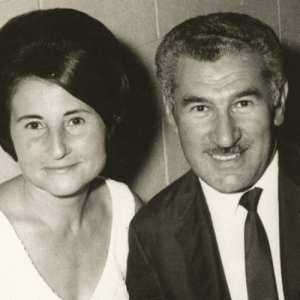Blog
February 27, 2023
Dressing for change: Jews, clothing and modernisation
By Education Officer, Dr Jonathan Kaplan
Prior to the nineteenth century, most of Europe’s Jewish population lived in “shtetls” – small Jewish villages outside of cities. During the nineteenth and early twentieth centuries, this started to shift, as many Jews moved closer to cities and became more engaged in dominant European society.
By the 1930s, most European Jews resided in cities, especially the capitals. By then, Jewish people had become a fixture of European society, with many of them identifying wholeheartedly with the dominant culture of their countries. Antisemitic agitation and later the introduction of policies – especially after the First World War – were intended to unravel Jewish citizens’ feelings of nationhood and belonging, separating them from the national body politic and depicting them as the “other”.
While much has been written about how European Jews became more closely engaged with the dominant culture over the course of the nineteenth century, few scholars have addressed the important contribution clothing made to this movement.
Clothing and the “modern” Jew
“Be a man in the streets and a Jew at home,” Lithuanian-born Maskil Judah Leib Gordon (1830–1892) wrote in his 1866 poem, Awake My People!
Here, Gordon is encouraging his fellow Jews to cast off the shackles of the shtetl to embrace modern Russian culture. This line is sometimes misunderstood as a call for complete assimilation, but that’s not what Gordon is doing. Rather than encouraging fellow regional Jews to abandon their culture, Gordon’s poem encourages Jews to take pride in their culture while also engaging with the societies in which they live.
Gordon doesn’t mention clothing in his poem, but surely “be a man in the streets” implies the adoption of modern dress?
We all wear clothes and often take their symbolic meanings for granted.
By the time Gordon wrote these words many Jews across Europe, both east and west, had started to adopt modern fashions, dressing in the same manner as their non-Jewish counterparts.
Numerous photographs from the Sydney Jewish Museum collection reveal the diversity of clothing Jews wore during the late nineteenth and early twentieth century.
By the eve of the Holocaust, most European Jews, save for Hasidim and members of other ultra-Orthodox communities, wore clothing that was indistinguishable from those around them.
How to dress correctly
Knowing how to dress correctly is not a given. Even in our own age, the meaning of “correct dress” is constantly evolving, dictated to us by designers, retailers, pop culture and—increasingly—social media. For acculturating Jews in the nineteenth and early twentieth centuries fashion was inspired in a similar manner to today: through theatre, journalism, print media, dedicated etiquette guides and, of course, observation.
Learning to dress “correctly” took time, and sometimes over multiple generations. A photograph from my own family collection depicts members of my great-grandmother’s family in 1920s Warsaw. In this staged scene, typical of studio photography of the period, members of the family crowd around a small table. The diversity of dress and grooming is apparent.
My great-great-great grandparents Mirjam and Chaim Majer Pszenica appear in the typical guise of Orthodox east-European Jews: Mirjam wears a “shaytl”, a wig commonly worn by devout married women, a frock buttoned up above her collarbone and sleeves covering her elbows in accordance to traditional conventions of “tzniut” (modesty), and Chaim Majer in his dark suit and large velvet “yarmulke” (skullcap).
The dress of the younger generation reveals this intergenerational change of style: from the finely tailored suit of Mirjam and Chaim Majer’s son, Isaak, giving him an overall “polished” appearance, to the modern blouses and frocks of the daughters with their wider necklines and short sleeves—a reflection of the wider change of European fashions during this period.
This photo is typical of countless others in our museum as well as private collections around the world. Viewed from our post-Holocaust perspective they appear as poignant reminders of the world that was before the destruction of European Jewry. But for historians of dress and Jewish culture, they also serve as important evidence in the complex interplay between acculturation, self-identification and rapidly changing societies.

Photo courtesy of the Kaplan family






What’s On Newsletter
Keep up to date on all Museum events and exhibitions.